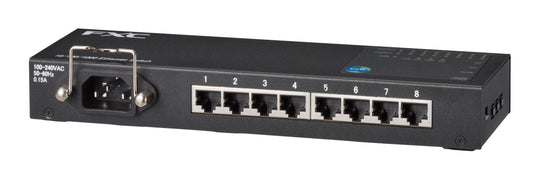
Case Study: Okinawa Cross-Head Corporation
Okinawa Cross-Head Corporation has implemented FXC's WDM and LEX1881-2F devices for the "Okinawa Cloud Network," which they manage and operate.
Becoming a Hub for Japan and Asia: The Challenge of Establishing an IT-Driven Prefecture
The IT industry in Okinawa Prefecture is now positioned as a leading sector, alongside tourism. The initiative to make Okinawa an "IT-driven prefecture" began with the "Okinawa Prefecture Multimedia Island Concept," formulated in September 1998. In 2002, the enforcement of the Special Measures Law for the Promotion of Okinawa's Development commenced based on this concept, driving forward the Information and Communications Industry Promotion Plan. Additionally, sectors like content and software development outsourcing, as well as Business Process Outsourcing (BPO), have experienced significant growth. Entering the 2010s, the culmination of efforts in the information and communications field arrived with the "Okinawa 21st Century Vision," a mid-to-long-term plan formulated by the prefecture in May 2012.
A key policy within the "Okinawa 21st Century Vision" is the "Okinawa Prefecture Asia Economic Strategy Concept," which outlines an economic growth strategy leveraging Okinawa's geographical advantages and sets five key strategies. Among these, the "Formation of a Leading International Information and Communications Hub in Asia: 'Smart Hub'," formulated in March 2013, is a strategy specifically focused on the information and communications sector. The "Okinawa Cloud Network" holds the key to Okinawa Prefecture's significant contribution to economic growth as a hub connecting Japan and Asia.
Managing the Okinawa Cloud Network
The "Okinawa Cloud Network" has been developed by Okinawa Prefecture since 2012 with several objectives: fostering new high-value-added cloud computing services within Okinawa, establishing distributed risk points to supplement domestic and international data backup functions, strengthening network expansion between data centers in the prefecture, and correcting disparities in internet connection costs both within and outside the prefecture.
Okinawa Cross-Head manages and operates the "Okinawa Cloud Network (Okinawa Prefecture Dedicated Line Network)" under a lease agreement with Okinawa Prefecture. Since August 2014, the company has been providing services to telecommunications carriers and SI (System Integration) providers, undertaking the comprehensive construction, maintenance, and operation of basic cloud computing systems. By proposing standardized systems, Okinawa Cross-Head has successfully delivered services at reasonable prices, reducing costs and shortening project timelines.
Uncovering User Needs During System Renewal
In April 2016, with the existing system's renewal approaching, Mr. Norikazu Kikumura, Sales Department Leader, seized the opportunity to initiate a system review. Mr. Kikumura recalls: "When the network was operational, with the renewal of the existing system, our top priority was to identify and organize the actual needs of the customers who were using it. As a result, we decided to enhance protocol compatibility, stability, and operational improvements as our main objectives, and to lower the layer of the entire core network."
Around the same time, Okinawa Prefecture began accelerating the formation of a leading international information and communications hub in Asia by developing the "Okinawa International Information and Communications Network." Mr. Kikumura's words convey the weight of the project at the time: "It became an urgent priority to prepare a minimum redundant configuration to meet customer needs as the 'Okinawa Cloud Network' had to accommodate a maximum 600G bandwidth from submarine cables connecting Okinawa-Tokyo, Okinawa-Hong Kong, and Okinawa-Singapore. Furthermore, an essential requirement was a configuration that would allow for easy design changes if additional bandwidth was needed in the future."
Selection Requirements and Key Selection Points
Mr. Akira Yonashiro, Design Team Leader of the Product Management Division within the Technical Operations Department, explained the background of the equipment selection. "As we progressed with our network investigation, we discovered that there were no available ports on the equipment at the base stations for the 10G lines we were providing to users. As a result of exploring solutions, we decided to lay new 10G lines by utilizing spare fiber cores, separate from the existing equipment configuration."
Mr. Yonashiro continued: "The primary requirement was a maximum distance of 100km across three locations, and the secondary requirement was a 40G or 100G backbone line. However, it was difficult to find equipment that met these requirements. After an extensive search, we finally arrived at FXC products. FXC products not only offered 100G wide bandwidth and 100km long-distance transmission performance, but their compact 1U size and easy configuration for maintenance and operation sealed the deal. I was confident that these were the right fit."
Subsequently, through repeated meetings between Okinawa Cross-Head and FXC sales and technical teams, and after equipment verification, the system was successfully launched in February 2017. Since some locations were far apart, extreme caution was exercised during installation, particularly with optical level measurements.
Mr. Yonashiro evaluated FXC products, stating, "Other companies' WDM products are very expensive. Media converters generally have low expandability. The LE100GM, positioned between these, has an intuitive WebGUI and was very easy to operate. As for the ultra-compact 10G media converter LEX1000 series used for connections between each location, it is incredibly user-friendly, has few failures, and offers excellent stability. Currently, we have 6 LE100GM units (3 pairs) and 16 LEX1881-2F units (8 pairs) installed, which are being utilized by carriers, cloud providers, and SI vendors."
Mr. Kikumura added, "The entire process, including evaluating other companies' products, took approximately one year until we decided on the implementation. The preparation and testing period added another six months until operation. Looking back, our persistence in sticking to our initial objectives and diligently searching truly paid off. We also collaborated with FXC to establish our staff training. FXC left a strong impression with their excellent sales and support responses. We hope they continue to provide highly stable products in the future."
This project was truly user-centric. In Okinawa Cross-Head's corporate culture, we recognized the very essence of their past growth and development.

